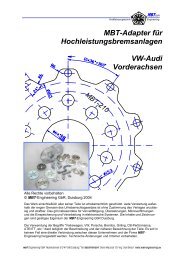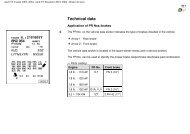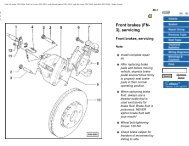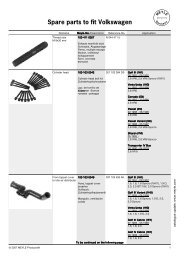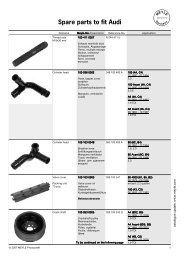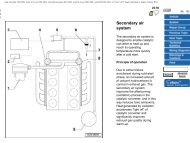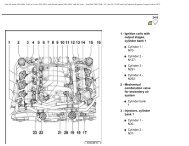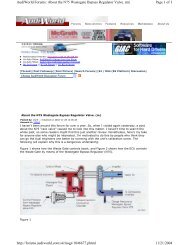VW MKII A2 MK2 Golf Jetta Fox Service Manual - VAGLinks.com
VW MKII A2 MK2 Golf Jetta Fox Service Manual - VAGLinks.com
VW MKII A2 MK2 Golf Jetta Fox Service Manual - VAGLinks.com
Create successful ePaper yourself
Turn your PDF publications into a flip-book with our unique Google optimized e-Paper software.
5A•4 Ignition system - contact breaker type<br />
Ignition advance is controlled both<br />
mechanically and by a vacuum-operated<br />
system. The mechanical governor mechanism<br />
<strong>com</strong>prises two weights, which move out from<br />
the distributor shaft as the engine speed rises<br />
due to centrifugal force. As they move<br />
outwards, they rotate the cam relative to the<br />
distributor shaft and so advance the spark.<br />
The weights are held in position by two light<br />
springs and it is the tension of these springs<br />
which is largely responsible for correct spark<br />
advancement.<br />
The vacuum control <strong>com</strong>prises a<br />
diaphragm, one side of which is connected<br />
via a small bore pipe to the inlet manifold and<br />
the other side to the contact breaker plate.<br />
Depression in the inlet manifold, which varies<br />
with engine speed and throttle opening,<br />
causes the diaphragm to move, so moving the<br />
contact breaker plate and advancing or<br />
retarding the spark. A fine degree of control is<br />
achieved by a spring in the vacuum assembly.<br />
The system incorporates a ballast resistor<br />
or resistive wire in the low tension circuit,<br />
which is in circuit all the time that the engine is<br />
running. When the starter is operated, the<br />
resistance is bypassed to provide increased<br />
voltage at the spark plugs for easier starting.<br />
Precautions<br />
It is necessary to take extra care when<br />
working on the electrical system to avoid<br />
damage to semi-conductor devices (diodes<br />
and transistors) and to avoid the risk of<br />
personal injury. Take note of the following<br />
points:<br />
a) Before disconnecting any wiring, or<br />
removing <strong>com</strong>ponents, always ensure that<br />
the ignition is switched off.<br />
b) Always remove rings, watches, etc.<br />
before working on the ignition system.<br />
Even with the battery disconnected,<br />
capacitive discharge could occur if a<br />
<strong>com</strong>ponent live terminal is earthed<br />
through a metal object. This could cause<br />
a shock or nasty burn.<br />
c) Do not reverse the battery connections.<br />
Components such as the alternator or any<br />
other having semi-conductor circuitry<br />
could be irreparably damaged.<br />
d) If the engine is being started using jump<br />
leads and a slave battery, connect the<br />
batteries positive to positive and negative<br />
to negative. This also applies when<br />
connecting a battery charger.<br />
e) Never disconnect the battery terminals, or<br />
alternator multi-plug connector, when the<br />
engine is running.<br />
f) The battery leads and alternator multiplug<br />
must be disconnected before<br />
carrying out any electric welding on the<br />
vehicle.<br />
g) Never use an ohmmeter of the type<br />
incorporating a hand cranked generator<br />
for circuit or continuity testing.<br />
h) The HT voltage generated by an<br />
electronic ignition system is extremely<br />
high and in certain circumstances, could<br />
prove fatal. Persons with surgicallyimplanted<br />
cardiac pacemaker devices<br />
should keep well clear of the ignition<br />
circuits, <strong>com</strong>ponents and test equipment.<br />
i) Do not handle HT leads, or touch the<br />
distributor or coil when the engine is<br />
running. If tracing faults in the HT circuit,<br />
use well insulated tools to manipulate live<br />
leads.<br />
2 Spark plugs - renewal<br />
2<br />
Caution: When pulling the HT lead from a<br />
spark plug, grip the rubber end fitting not<br />
the lead, otherwise the lead connection<br />
may be fractured<br />
Note: To prevent dirt from dropping into the<br />
cylinders, remove dirt from the spark plug<br />
recesses before removing the plugs<br />
Refer to Chapter 1, Section 15<br />
3 HT leads, distributor cap and<br />
rotor arm - inspection and<br />
renewal<br />
2<br />
1 Clean all HT and LT leads by wiping along<br />
their length with a fuel-moistened cloth.<br />
Inspect each lead for damage and renew if<br />
defective in any way.<br />
2 Note the fitted position of each HT lead<br />
before disconnection. When removing a lead<br />
from a spark plug or the HT coil, pull the lead<br />
off by its rubber connector, not the lead itself.<br />
3 The socket contacts on the distributor cap<br />
and HT coil should be cleaned if corroded. A<br />
smear of petroleum jelly (not grease) applied<br />
to the ferrule on the end of the HT lead will<br />
help to prevent corrosion.<br />
4 Remove the distributor cap and rotor arm.<br />
5 Examine the rotor arm and inside of the<br />
distributor cap . If the contacts are corroded<br />
or are excessively burnt, or if the carbon<br />
centre contact in the cap is worn away, renew<br />
the cap or rotor, as necessary. Check<br />
carefully for hairline cracks and signs of<br />
arcing.<br />
6 Ensure that all HT leads are reinstalled in<br />
their correct firing order. Check that all leads<br />
6.5 Condenser location<br />
1081 <strong>VW</strong> <strong>Golf</strong> & <strong>Jetta</strong><br />
are correctly routed and clear of moving or<br />
hot engine <strong>com</strong>ponents. Ensure that all lead<br />
connections are secure and where applicable,<br />
protected.<br />
4 Contact breaker points -<br />
inspection and adjustment 3<br />
Inspection<br />
Refer to Chapter 1, Section 11<br />
Adjustment<br />
Refer to Chapter 1, Section 16<br />
5 Contact breaker points -<br />
renewal 3<br />
Refer to Chapter 1, Section 16<br />
6 Condenser - testing, removal<br />
and refitting 2<br />
Testing<br />
1 A faulty condenser can cause <strong>com</strong>plete<br />
failure of the ignition system, as the points will<br />
be prevented from interrupting the low tension<br />
circuit.<br />
2 To test the condenser, remove the<br />
distributor cap, rotor arm and dust cover and<br />
rotate the engine until the contact points are<br />
closed. Switch on the ignition and separate<br />
the points. If this is ac<strong>com</strong>panied by a strong<br />
blue flash, the condenser is faulty. Note that a<br />
weak white spark is normal.<br />
3 A further test can be made for short<br />
circuiting by removing the condenser and<br />
connecting a test lamp and leads to the<br />
supply lead and body (ie. connecting the<br />
condenser in series with a 12 volt supply). If<br />
the test lamp lights, the condenser is faulty.<br />
4 If correct operation of the condenser is in<br />
doubt, substitute a new unit and check<br />
whether the fault persists.<br />
Removal<br />
5 To remove the condenser, unscrew its<br />
retaining screw and disconnect the LT supply<br />
lead (at the coil on some models) (see<br />
illustration).<br />
6 Withdraw the condenser far enough to<br />
disconnect the moving contact supply lead<br />
then withdraw the condenser. If the moving<br />
contact supply lead has insufficient length, it<br />
will be necessary to remove the distributor<br />
cap, rotor arm, dust cover and bearing plate (if<br />
applicable) first.<br />
Refitting<br />
7 Refitting is a reversal of removal.



